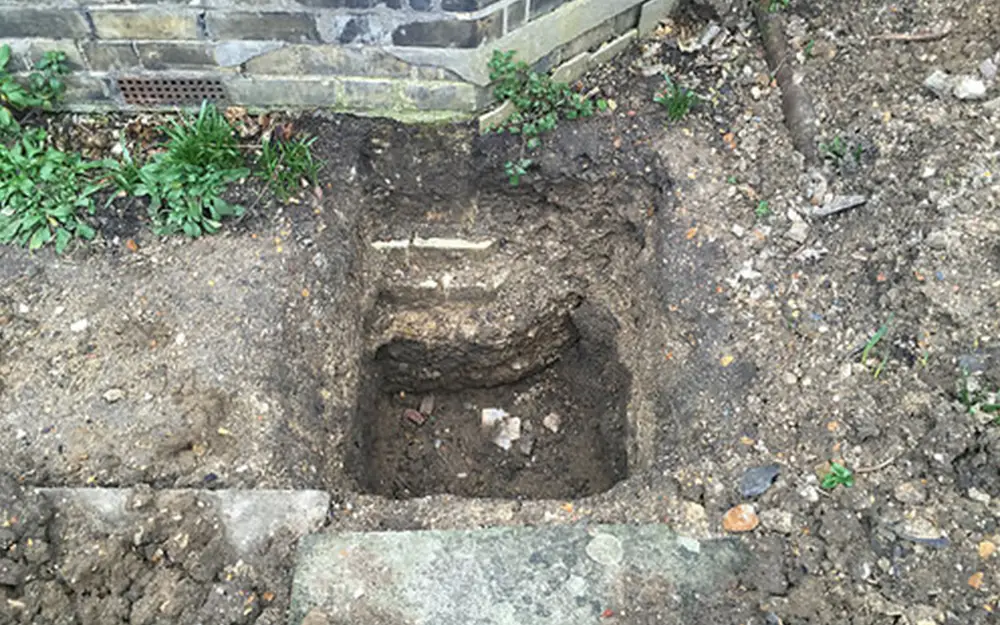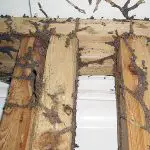Rats burrow anywhere from a few inches to several feet deep into the ground. Now let’s delve into the topic of rat burrowing.
Rat burrowing is a common behavior among these pests, enabling them to create underground shelters and travel discreetly. The depth at which rats burrow can vary depending on various factors such as soil condition and the rat species. Typically, rats dig burrows that range from a few inches deep to several feet below the surface.
These burrows serve as nesting areas, food storage, and pathways for rats to move around. Rat burrows are often found in areas with loose soil, such as gardens, compost heaps, and under buildings. Understanding the depth of rat burrows is essential in pest management as it aids in identifying potential nesting areas and implementing effective control measures.

Credit: www.the-scientist.com
Why Do Rats Burrow
Rats burrow primarily for shelter and protection from predators. Their burrows can range from a few inches to several feet deep, depending on the availability of suitable nesting sites and food sources.
Rats are known for their ability to burrow and create intricate tunnel systems. But have you ever wondered why rats have this natural instinct to burrow? In this section, we will explore the reasons behind their burrowing behavior. Here’s a breakdown of why rats burrow:
Natural Instinct For Rats To Burrow
- Rats have a natural instinct to burrow, which is deeply rooted in their dna.
- Burrowing allows rats to establish territories, provide safety, and ensure survival.
- This behavior is inherited from their ancestors, who had to burrow to protect themselves from predators and harsh weather conditions.
Creating Safe Shelter And Nesting Areas
- Burrowing offers rats a sense of security, providing them with shelter and protection from predators, extreme temperatures, and other threats.
- By excavating tunnels and burrows, rats can create complex networks that serve as comfortable nesting areas for raising their young.
- These burrows often have multiple entrances and exits, allowing for quick escape routes if needed.
Access To Food Sources
- Rats are highly opportunistic creatures, always in search of food to satisfy their voracious appetites.
- Burrowing enables rats to gain access to various food sources, such as crops, gardens, trash cans, and stored goods.
- By burrowing close to these food sources, rats can establish easy access points, reducing the time and effort required to obtain sustenance.
Rats burrow due to their innate instinct, need for safe shelter and nesting areas, and the desire to access food sources. This behavior allows rats to establish and protect their territories while ensuring their survival. Understanding the reasons behind rat burrowing can shed light on effective pest control methods and help mitigate the issues associated with their presence.
Factors Affecting Rat Burrowing Depth
Factors such as soil type, environmental conditions, and food availability influence the depth at which rats burrow. Their burrows can range from a few inches to several feet underground.
Rat burrowing behavior is a fascinating topic that begs the question: how deep do rats actually burrow? The depth at which rats dig their burrows can be influenced by various factors, including soil type and composition, environmental conditions, as well as the availability of food and water sources.
Let’s explore these factors in more detail:
Soil Type And Composition:
- Sandy soil: Rats find it relatively easy to dig through sandy soil due to its loose and grainy texture.
- Clay soil: Burrowing through clay soil can be more challenging for rats, as it is denser and holds moisture better.
- Loamy soil: Rats may prefer burrowing in loamy soil due to its balance of sand, silt, and clay, which offers good workability without excessive moisture retention.
- Soil depth: Deeper soil layers may pose more resistance to burrowing, potentially limiting the depth at which rats can dig.
Environmental Conditions:
- Temperature and climate: Rats tend to burrow deeper during periods of extreme weather conditions to seek refuge from heat or cold.
- Moisture levels: Soil moisture content plays a role in rat burrowing depth, with wetter soil making it easier for rats to dig deeper.
- Stability and safety: Rats may adjust their burrowing depth based on the stability and safety of the surrounding environment, avoiding areas prone to collapse or flooding.
Available Food And Water Sources:
- Proximity to food: Rats may dig deeper burrows if their food source is located deep underground, enabling them to easily access and store food.
- Water requirements: If water sources are scarce on the surface, rats may burrow deeper to reach underground water tables or to create their own water storage areas.
These are just some of the factors that can influence the depth at which rats burrow. By understanding these factors, we can gain insights into rat behavior and their strategies for survival. Keep in mind that rats are highly adaptable creatures, capable of adjusting their burrowing depth based on the conditions they encounter in their environment.
Rat Burrowing Depth Variations
Rat burrowing depths can vary considerably, with some rats digging tunnels as shallow as a few inches, while others burrow as deep as several feet underground. Understanding these variations is crucial for effective pest control strategies.
Different Rat Species And Sizes
- Rats vary in terms of species and sizes, which in turn affects their burrowing behavior. Here are some key points to consider:
- Norway rats (rattus norvegicus) are known for their extensive burrowing habits, digging burrows up to 18 inches deep. These burrows serve multiple purposes, including nesting, breeding, and seeking shelter from predators and extreme weather conditions.
- Roof rats (rattus rattus) are agile climbers and prefer nesting above ground. However, they may still dig burrows in search of food or protection. These burrows are generally shallower, ranging from a few inches to about a foot deep.
- Smaller rat species, such as the black rat (rattus rattus) and the house mouse (mus musculus), typically do not burrow extensively. Instead, they seek shelter in existing structures, creating nests within walls, ceilings, or other hidden areas.
- The size of the rat also plays a role in burrowing depth. Larger rats, such as norway rats, are capable of excavating deeper burrows due to their stronger physical capabilities.
Urban Versus Rural Environments
- The environment in which rats live significantly influences their burrowing habits. Consider the following factors:
- Urban environments typically offer rats easy access to human-made structures, such as buildings and sewers. As a result, rats in urban areas often rely less on burrowing and more on exploiting these existing structures for shelter and food sources.
- In contrast, rats in rural or natural environments may heavily rely on burrowing for various purposes. With less human-made structures available, rats in these areas are more likely to dig deeper and more extensive burrows to establish nests and protect themselves from predators.
- However, it’s essential to note that urbanization can still present opportunities for rats to create burrows, especially in abandoned or neglected areas where vegetation is overgrown, or infrastructure is compromised.
Access To Natural Burrowing Materials
- The availability of natural burrowing materials can significantly impact rat burrowing behavior. Consider the following points:
- In natural habitats, rats have access to a wide range of materials ideal for burrowing, such as soil, vegetation, and tree roots. These materials enable rats to create complex tunnel systems for nesting and safe passage.
- In urban environments, rats may utilize alternative materials for burrowing, such as loose soil, debris, or even man-made materials like insulation and packaging materials. While these materials do not offer the same level of stability as natural ones, rats can still excavate shallow burrows for basic protection.
- Additionally, access to natural burrowing materials can be limited in urban areas due to paved surfaces, concrete structures, and the general absence of vegetation. This scarcity of suitable materials may restrict rats in urban environments to find alternative burrowing options or rely more on existing structures.
Understanding the variations in rat burrowing depth is crucial for effective pest control and management strategies. By recognizing the different species, considering the impact of urbanization, and understanding the availability of natural burrowing materials, we can develop targeted approaches to minimize rat populations and mitigate potential damages.
Case Studies On Rat Burrowing Depth
Discover the case studies investigating the depths at which rats burrow. Uncover the fascinating findings to understand just how deep these rodents can dig.
Rats are notorious for their ability to burrow, making them adept survivors. Understanding the depths to which rats can burrow is crucial for effective pest control measures. In this section, we will explore some case studies that have shed light on the burrowing behavior of rats, highlighting the depths they can reach in different scenarios and locations.
Research Studies Highlighting Rat Burrow Depths:
- A study conducted in urban settings found that rats tend to burrow to depths ranging from 12 to 18 inches. This relatively shallow burrowing behavior enables them to create extensive tunnels for nesting and food storage.
- In an agricultural research project, rats were observed to burrow up to 3 feet deep in fields. The study indicated that the depth of burrows often depended on the availability of food and water sources, as well as the soil composition.
- Research conducted in coastal areas revealed that rats displayed a greater tendency to burrow deeper due to unstable ground conditions. Some burrows were found to reach depths of over 5 feet, allowing rats to establish colonies and elude predators more effectively.
These case studies provide valuable insights into the burrowing capabilities of rats under various conditions and environments. Now, let’s delve into the experiments conducted in diverse locations.
Experiments Conducted In Various Locations:
- In a study carried out in urban neighborhoods, researchers discovered that rats primarily burrowed near structures such as foundations, walls, and sidewalks. The proximity to these structures offered them protection and easy access to food sources.
- Experiments conducted in rural areas demonstrated that rats were more likely to burrow in open fields, away from human settlements. The absence of structural restrictions allowed them to create complex tunnel systems and seek refuge in extensive burrows.
- Research in coastal regions showed that rats frequently burrowed in dunes and vegetation near shorelines. These burrows served as shelters against the volatile coastal climates and provided rats with easy access to food sources in the surrounding areas.
These experiments reveal that rats adapt their burrowing behavior to their surroundings, taking advantage of available resources to ensure their survival. Now, let’s move on to a comparative analysis of rat burrowing behavior.
Comparative Analysis Of Rat Burrowing Behavior:
- Urban versus rural burrowing: Rats in urban areas tend to burrow closer to human infrastructure, while rural rats prefer open fields. This distinction is primarily influenced by the availability of resources and the level of human activity in the vicinity.
- Coastal versus inland burrowing: Rats in coastal regions display deeper burrowing tendencies compared to their inland counterparts. The unstable ground conditions and the need for protection from harsh coastal environments contribute to this behavioral difference.
Analyzing the burrowing behavior of rats in different scenarios helps us understand their adaptability and strategizing abilities. This knowledge is vital for implementing effective pest control strategies, ensuring the prevention and containment of rat infestations. Remember, a proactive approach is key to managing these persistent invaders.
Understanding Rat Burrowing For Effective Pest Control
Rats are known for their exceptional burrowing abilities, digging tunnels that can extend up to several feet deep. Understanding how deep rats burrow is crucial for effective pest control, allowing you to implement measures to prevent their entry and protect your property.
Importance Of Knowing Rat Burrow Depths For Eradication:
- Understanding the depth to which rats burrow is crucial for effective pest control measures. By having this knowledge, you can implement strategies that specifically target their burrowing behavior and make eradication more successful.
- Knowing how deep rats can dig allows you to locate and target their nests, which are typically found in their burrows. This helps in eliminating the entire rat population rather than just scattering them.
- Rat burrows also serve as their safe haven, providing protection against predators and harsh weather conditions. Therefore, knowing the depth of their burrows helps in locating rat-infested areas and implementing appropriate control methods.
Tailoring Pest Control Strategies Based On Burrowing Behavior:
- Rat burrowing behavior varies depending on the species, environmental factors, and the availability of suitable areas for burrowing. By understanding these behaviors, you can customize your pest control strategies to target specific areas of concern.
- Different species of rats exhibit different burrowing depths. For instance, norway rats tend to dig deeper burrows compared to roof rats. By identifying the species infesting your property, you can adapt your control methods accordingly.
- Implementing baiting systems or traps in close proximity to burrows increases the chances of capturing or eliminating rats. This targeted approach is more effective than relying solely on general bait placements or traps placed randomly.
Preventing Rat Access To Suitable Burrowing Areas:
- A key aspect of rat control is preventing their access to suitable burrowing areas. By blocking or removing these entry points, you can significantly reduce the likelihood of rat infestations on your property.
- Conducting regular inspections of your property will help identify potential burrowing areas, such as holes, gaps, or cracks in foundations, walls, or outdoors. Repairing these openings prevents rats from establishing burrows or accessing existing ones.
- Reducing clutter, debris, and overgrown vegetation in and around your property eliminates potential hiding spots or nesting materials for rats. This reduces their motivation to burrow or create new burrows on your premises.
- Implementing proper waste management practices, such as securely storing garbage in rat-proof containers, helps minimize the availability of food sources that may attract rats to burrow near waste areas.
Remember, understanding rat burrowing depths is crucial for effective pest control. By tailoring strategies based on their burrowing behavior and preventing their access to suitable burrowing areas, you can successfully eradicate rats from your property. So, take the necessary steps and stay ahead in the battle against these pesky rodents.
Methods To Prevent Rats From Burrowing
Rats are known to burrow extensively, with some reaching depths as great as 3 feet. To prevent rats from burrowing, one can use various methods such as sealing openings in foundations, installing wire mesh barriers, and removing outdoor debris that can provide hiding spots.
These preventive measures help to keep rats away and protect your property from their destructive burrowing habits.
Rats are notorious creatures that can wreak havoc on structures by burrowing and creating extensive tunnels. To protect your property from these persistent pests, it is essential to implement effective rat prevention methods. Here are some methods you can use to prevent rats from burrowing:
Sealing Entry Points And Cracks In Structures:
- Inspect your property thoroughly and identify any potential entry points or cracks that rats can exploit. Common areas to check include gaps in the foundation, vents, pipes, windows, and doors.
- Use materials such as mesh wire, caulk, or heavy-duty screening to seal all identified entry points and cracks. Pay special attention to smaller openings, as rats can squeeze through surprisingly narrow gaps.
- Reinforce door sweeps and weather-stripping to ensure a tight seal, preventing rats from sneaking indoors.
- Regularly maintain and repair damaged structures, such as damaged roofs or foundations, which can become easy access points for rats.
Installing Barrier Systems To Deter Rat Burrowing:
- Install underground barriers such as rat-proof wire mesh or hardware cloth around the perimeter of your property. These barriers should extend at least 12 inches below ground level and be embedded 6 inches above the ground to create an effective deterrent against rat burrowing.
- Place thick wire mesh or grating over the bottom of outdoor structures like sheds or decks to prevent rats from burrowing underneath.
- Consider using concrete pads or foundations for structures like air conditioning units or garbage bins, as rats find it difficult to burrow through concrete.
Environmental Modifications To Reduce Attractive Burrowing Conditions:
- Remove or trim dense vegetation, shrubs, and overgrown plants near your property. Rats are attracted to these areas as they provide cover and make burrowing easier.
- Keep your yard tidy and free of clutter, including piles of wood, debris, or unused items that rats can use as hiding spots or nesting materials.
- Store food items securely in rodent-proof containers, ensuring that they are properly sealed and stored above ground level.
- Dispose of garbage regularly and maintain clean surroundings to minimize food sources for rats.
- Avoid leaving pet food or water bowls outside for extended periods, as they can attract rats. If you feed pets outdoors, remove any uneaten food promptly.
- Regularly inspect and maintain drainage systems to prevent pooling or stagnant water, which can attract rats.
Implementing these prevention methods will significantly reduce the risk of rats burrowing on your property and protect your structures from potential damage. Stay vigilant and take proactive measures to keep these unwanted rodents at bay.
Protecting Gardens And Landscapes
Protect your gardens and landscapes by understanding how deep rats can burrow. Learn about their digging abilities to develop effective strategies for keeping your outdoor spaces pest-free.
Rats can cause significant damage to gardens and landscapes through their burrowing habits. Whether it’s garden beds, crops, or overall landscape aesthetics, it is important to implement protective measures to minimize the impact of rat burrowing. This section will explore various strategies to safeguard your gardens and landscapes from rat damage.
Protective Measures For Garden Beds And Crops:
- Install hardware cloth: Cover the bottom of garden beds with hardware cloth to prevent rats from burrowing up into them.
- Use wire mesh: Surround vulnerable plants and crops with wire mesh enclosures to create a barrier against rats.
- Raised beds: Consider using raised beds, as rats find it more challenging to burrow through elevated soil.
Natural Deterrents Against Rat Burrowing:
- Mint plants: Planting mint around your garden can act as a natural deterrent, as rats dislike the strong scent of mint.
- Catnip: Similar to mint, catnip can repel rats due to its strong odor.
- Garlic and onions: The pungent smell of garlic and onions can also discourage rats from approaching your garden beds and crops.
- Predator urine: Sprinkling predator urine, such as that of coyotes or foxes, around your garden can send a signal to rats that a predator is nearby.
Strategies To Minimize Rat Damage To Landscapes:
- Remove potential shelters: Clear out any debris, dense vegetation, or clutter that could serve as hiding spots for rats.
- Proper waste management: Ensure that trash bins are securely sealed and don’t provide easy access for rats.
- Regular maintenance: Regularly inspect your landscapes for signs of rat activity, such as burrow holes, and address them promptly.
- Limit food sources: Avoid leaving pet food or bird feeders out overnight, as they can attract rats.
By implementing these protective measures and natural deterrents, you can reduce the risk of rat burrowing and preserve the health and aesthetics of your gardens and landscapes. Stay proactive and vigilant in maintaining a rat-free environment to ensure the success of your gardening endeavors.
Preventing Structural Damage
Rats can burrow to a depth of up to 1 meter, causing potential structural damage to buildings and underground infrastructure. It is important to take preventive measures to protect your property from these pests.
Understanding The Risks Of Rat Burrowing To Buildings
Rats are notorious for their ability to burrow through various materials, causing damage to buildings and structures. Understanding the risks associated with rat burrowing is crucial in order to prevent potential structural damage. Here, we will discuss the potential hazards and offer solutions to safeguard your property.
Inspecting And Reinforcing Vulnerable Areas
Taking preventative measures is essential in protecting your building from rat burrowing. By regularly inspecting and reinforcing vulnerable areas, you can significantly reduce the risk of structural damage. Here are some steps you can take:
- Identify weak points: Thoroughly examine your property to locate areas where rats are likely to burrow. Pay close attention to foundations, utility entry points, and gaps around doors and windows.
- Seal cracks and holes: Fill any cracks or gaps in walls, floors, or foundations using concrete, steel mesh, or other suitable materials. This will deny rats entry and prevent them from burrowing further.
- Install wire mesh barriers: Cover air vents, utility openings, and crawl spaces with wire mesh screens to prevent rats from accessing these areas. This will effectively deter their burrowing attempts.
Intervention Methods To Prevent Structural Damage
In addition to reinforcing vulnerable areas, there are intervention methods that can be implemented to prevent structural damage caused by rat burrowing:
- Use rodent-proof materials: Employ materials that are resistant to rat burrowing when constructing or renovating your property. Examples include concrete with embedded steel mesh, metal flashing, and chew-proof insulation.
- Employ chemical deterrents: Applying rodent-repellent chemicals around vulnerable areas can deter rats from burrowing. Consult with pest control professionals to identify suitable products for your specific needs.
- Maintain cleanliness and hygiene: Keep your surroundings clean, eliminating potential food sources for rats. Dispose of garbage properly and ensure that food storage areas are secure. A clean environment will discourage rats from inhabiting or burrowing near your building.
By understanding the risks, inspecting and reinforcing vulnerable areas, and implementing intervention methods, you can effectively prevent rats from causing structural damage to your building. Stay proactive in your efforts to protect your property and ensure its longevity.
Importance Of Understanding Rat Burrowing Behavior
Understanding rat burrowing behavior is crucial in managing infestations effectively. By knowing how deep rats can burrow, you can implement targeted control strategies to prevent damage to structures, as well as potential health and safety risks.
Rats are notorious for their ability to burrow deep into the ground, causing significant problems for homes, businesses, and public areas. Understanding the behavior and habits of these creatures is crucial for effective pest control and prevention efforts. By gaining insight into how deep rats burrow and their preferred nesting sites, property owners can devise strategies to mitigate risks and protect their premises.
Ongoing monitoring and maintenance are key to keeping rat populations under control and minimizing the damage they can cause.
Impact On Pest Control And Prevention Efforts:
- Rats can create extensive underground tunnels, which can undermine the structural integrity of buildings and cause damage to utilities such as water and gas lines.
- Burrowing behavior allows rats to establish hidden nests and breeding sites, making it challenging to locate and eliminate them.
- Rat burrows can serve as entry points for other pests, such as snakes or insects, further complicating pest control efforts.
- Understanding the depth and extent of rat burrows helps pest control professionals develop targeted strategies to eradicate rat populations effectively.
Strategies To Mitigate Risks And Protect Properties:
- Conduct a thorough inspection of the property to identify signs of rat burrowing, such as holes in the ground, gnawed objects, or droppings.
- Seal off potential entry points, including gaps in walls, windows, doors, and utility lines, to prevent rats from entering the property.
- Remove any potential food and water sources that may attract rats, such as uncovered trash bins, spilled pet food, or standing water.
- Implement effective rodent control measures, such as setting traps or using bait stations, in areas known for rat activity.
- Consider using pest control professionals, who have the expertise and knowledge to handle rat infestations safely and effectively.
The Need For Ongoing Monitoring And Maintenance:
- Rat populations can quickly multiply, so regular monitoring is essential to detect and address infestations early on.
- Continually inspect the property for new signs of rat activity and address any issues promptly.
- Maintain cleanliness and proper waste management practices to reduce the likelihood of attracting rats.
- Regularly check and maintain rodent control measures, such as traps or bait stations, to ensure their effectiveness.
- Stay informed about new pest control methods and best practices to stay ahead of evolving rat behaviors and prevention techniques.
Understanding rat burrowing behavior is crucial for effective pest control and prevention. By implementing appropriate strategies, regular monitoring, and ongoing maintenance, property owners can protect their premises against rat infestations. Stay vigilant and take proactive measures to keep these destructive rodents at bay.
Frequently Asked Questions For How Deep Do Rats Burrow
How Deep Do Rats Burrow?
Rats are skilled diggers and can burrow up to 3 feet deep into the ground. Their burrows serve as nesting sites, food storage, and escape routes from predators. The depth of their burrows helps protect them from extreme weather conditions and provides a safe environment for breeding.
Conclusion
To sum it up, rats are skilled burrowers, capable of digging elaborate tunnels that can span several feet underground. Their burrowing behavior serves multiple purposes, including creating shelter, finding food sources, and establishing nesting sites. The depth to which rats burrow can vary depending on various factors such as the type of soil, availability of food and water, and presence of predators.
In urban areas, rats often burrow in sewers, foundations, and crawl spaces, presenting a potential risk to buildings and infrastructure. It is important to remember that rats can cause significant damage and pose health risks, making effective control measures necessary.
By understanding the depth to which rats can burrow, it becomes easier to implement strategies to prevent their intrusion and mitigate the potential harm they can cause. So, if you suspect rat activity on your property, it is crucial to take immediate action to minimize their presence and protect yourself and your surroundings.

“My name is Leo Jacob, and I hold a Bachelor of Science degree with Honors in Applied Environmental Science and Sustainability from the University of the West of Scotland. Since childhood, I’ve been passionate about living an eco-friendly life. After completing my studies, I dedicated myself to finding simple ways to lead a more environmentally conscious lifestyle. I launched ecolifely.com to share my educational background and practical experiences with everyone, hoping to inspire others to join me in creating a greener, more sustainable world.”












Leave a Reply